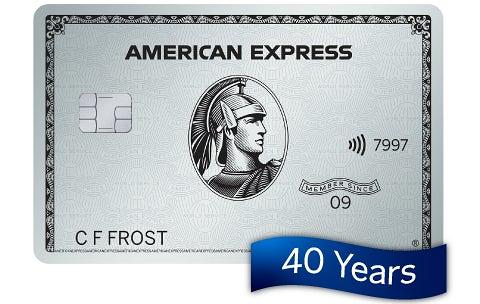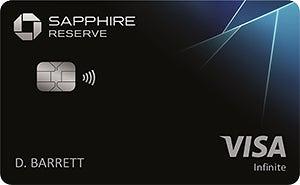The Platinum Card® from American Express and the Chase Sapphire Reserve® are among the most expensive credit cards on the market. However, if you’re a travel enthusiast, the benefits these premium credit cards offer can easily outweigh their costs.
But with many overlapping perks, it doesn’t make sense for most people to have both, so it’s important to carefully compare the two options to determine which is better for you. Here’s what you need to know.
In this article:
Platinum Card from American Express overview
Rewards rate
- 5x points for flights booked directly with airlines or with American Express Travel (up to $500,000 per year)
- 5x points on prepaid hotels booked with American Express Travel
- 1x points on all other purchases
The Amex Platinum offers up a wide range of statement credits and travel perks, but lacks significant rewards for everyday spending.
Why we like it: You’ll be hard-pressed to find a credit card that offers more value than the Amex Platinum. While the reward rates on purchases aren’t especially notable, you can get more than $1,500 in value every year in the form of statement credits toward digital entertainment, airline fees, prepaid hotel stays, a Walmart+ subscription, purchases with Saks Fifth Avenue, and a CLEAR subscription. You’ll also get Uber Cash each month, which you can use for Uber rides or Uber Eats delivery.
The card also offers complimentary access to several airport lounge networks, elite status with Marriott Bonvoy, Hilton Honors, Avis, Hertz, and National Car Rental, and many other travel and lifestyle benefits.
Amex Platinum Card pros
Generous welcome offer: The card offers a sizable sign-up bonus, and while the spending requirement is steep, Amex gives you six months to meet the threshold instead of the standard three.
Unparalleled benefits: It may take you some time to make the most of the card, partially because there are so many perks to keep track of. But if you’re a frequent traveler, the Platinum Card can elevate nearly every aspect of each trip you take.
Prestige: The Platinum Card has been the standard for other premium credit cards since it first launched in 1984. The heft of the metal card and classic Centurion design adds cachet to your wallet.
Amex Platinum Card cons
Maximizing rewards can take some work: Due to the structure of many of the card’s statement credits, it can take some strategy to make the most of what it offers. Be prepared to track your rewards regularly in order to ensure you’re getting all the value you can from the card.
Spending rewards are lacking: The card doesn’t offer any bonus rewards on everyday spending categories, and while Membership Rewards points are flexible, most redemption options will give you less than 1 cent per point in value, which is the standard for points and miles credit cards. Generally, your best bet is to transfer your rewards to one of Amex’s airline or hotel loyalty program partners.
Steep annual fee: While you can expect a high annual fee for any premium credit card, the Platinum Card’s is higher than most. That may not be an issue if you regularly take advantage of the card’s perks, but it’s a major obstacle for most people.
Chase Sapphire Reserve overview
Rewards rate
- 10x points on hotels and rental cars purchased through Chase Travel
- 5x points on flights purchased through Chase Travel
- 3x points on dining and other travel purchases
- 1x points on all other purchases
The Chase Sapphire Reserve serves up an attainable welcome offer, but the highest rewards on spending are only offered on travel booked through Chase.
Why we like it: The Chase Sapphire Reserve is a rewards powerhouse, offering several ways to rack up a ton of points in a variety of spending categories. What’s more, the Chase Ultimate Rewards program offers both versatile and valuable redemption options.
While you can redeem your rewards for things like cash back and gift cards at a rate of 1 cent per point, you’ll get 50% more value if you use your points to book travel through Chase’s travel portal. Alternatively, you can transfer your rewards to more than a dozen airline and hotel loyalty programs.
The card also offers complimentary access to Priority Pass and Chase Sapphire lounges, a flexible annual travel credit worth $300, and several travel protections to give you peace of mind when a trip doesn’t go as planned.
You’ll also get a complimentary two-year Lyft Pink membership, a complimentary DoorDash DashPass subscription (when you activate by Dec. 31, 2024) and $5 in DoorDash credits each month, and a complimentary one-year Instacart+ membership and up to $15 in monthly statement credits through July 2024.
Chase Sapphire Reserve pros
Massive welcome bonus: The card’s welcome bonus is significant, especially if you use your hard-earned points to book travel through Chase.
Impressive rewards program: You’ll not only earn great rewards on various spending categories, but you’ll also get incredible value when you use your rewards to book travel through Chase. If you’re taking a break from travel, you can safely redeem your rewards in other ways without losing too much value.
Great perks: While it’s not as comprehensive as the Amex Platinum, the Sapphire Reserve offers a lot of value with its flexible travel credit, airport lounge access, and other travel benefits.
Chase Sapphire Reserve cons
Rewards are somewhat complicated: While the card’s rewards program is incredibly valuable, there may be a steep learning curve when it comes to tracking all the bonus categories and maximizing the value out of your redemptions.
High annual fee: While the Sapphire Reserve charges a lower annual fee than the Platinum Card, it doesn’t offer as many ways to offset that cost each year, making it harder to justify with perks alone.
Must book through Chase to get highest rewards: While the card offers a solid 3x points on general travel and dining, the highest rewards for spending are reserved for travel booked through the Chase portal. For those who prefer to book directly with the travel provider, this could be an added hassle.
Should you get Amex Platinum Card?
You may consider the Platinum Card if you’re a frequent traveler and value premium benefits on every trip you take.
However, the card’s steep annual fee and complicated perks are best suited for people who are willing to do a little extra legwork to squeeze as much value out of it as possible.

Should you get Chase Sapphire Reserve?
The Sapphire Reserve is a bit more accessible than the Platinum Card, both in terms of its yearly cost and straightforward benefits. You may also prefer this option if you want to focus on earning rewards.
That said, it doesn’t offer nearly as much value on the benefit side of things, so if your priority is enjoying premium travel perks, it might not be the best fit.

Does it make sense to get both cards?
For the most enthusiastic travel rewards hobbyists, there are enough differences between the two cards to justify getting the best of both worlds. True jet-setters may want to maximize the spending rewards of the Sapphire Reserve and the luxury perks of the Amex Platinum.
However, the majority of people likely aren’t willing to pay $1,245 in annual fees to carry both cards. And unless you’re traveling constantly, the perks overlap enough that you’ll have a hard time maximizing either card.
Other travel cards to consider
While the Amex Platinum and Sapphire Reserve are two of the top premium cards on the market, there are plenty of other travel credit cards that offer ample rewards and benefits.
Capital One Venture X Rewards Credit Card: Straightforward rewards and premium perks
Why we like it: The Capital One Venture X Rewards Credit Card is a premium travel credit card that can work for both frequent and casual travelers alike. The card offers 75,000 bonus miles when you spend $4,000 in the first three months, as well as bonus rewards on travel booked through Capital One and a flat 2 miles per dollar spent on all other purchases.
The card charges a hefty $395 annual fee, but you can easily offset that with its annual $300 credit toward Capital One Travel bookings and a 10,000-mile anniversary bonus each year. The Venture X card also offers complimentary access to a few airport lounge networks and flexible redemption options. You can use miles to book travel through Capital One, book on your own and request a statement credit, or transfer your rewards to several airline and hotel loyalty program partners.
Recommended credit score: Excellent
Chase Sapphire Preferred® Card: Great spending rewards and a low annual fee

Why we like it: The Chase Sapphire Preferred Card’s $95 annual fee is easier to stomach compared to other premium cards. That said, the card still offers impressive value. Its welcome bonus equals that of the Sapphire Reserve, and it offers solid rewards on things like travel, dining, select online grocery purchases, and streaming services.
You’ll get the same redemption options as the Sapphire Reserve, though the bonus for travel bookings through Chase is 25%, instead of the Reserve’s 50%. The Sapphire Preferred also offers up to $50 in statement credits each year on hotel stays booked through Chase.
Recommended credit score: Good – Excellent
Capital One Venture Rewards Credit Card: Simple travel rewards and an affordable annual fee
Why we like it: As with the Sapphire Preferred, the Capital One Venture Rewards Credit Card charges a modest $95 annual fee. It also offers the same welcome bonus as the Venture X and similar rewards to boot — though the bonus rates on travel booked through Capital One Travel are lower.
The Venture Rewards Card also offers the same flexible travel redemption options as the Venture X, making it easy to use your rewards for any kind of travel. On top of that, you’ll get an application fee credit toward Global Entry or TSA PreCheck and elite status with Hertz.
Recommended credit score: Good – Excellent
This article was edited by Alicia Hahn
Editorial Disclosure: The information in this article has not been reviewed or approved by any advertiser. The details on financial products, including card rates and fees, are accurate as of the publish date. All products or services are presented without warranty. Check the bank’s website for the most current information. This site doesn’t include all currently available offers. Credit score alone does not guarantee or imply approval for any financial product.
Credit: Source link



